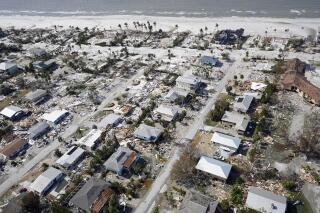Extreme weather events are becoming more severe, not less

FILE - Debris surrounds damaged homes in the aftermath of Hurricane Ian, Sept. 29, 2022, in Fort Myers Beach, Fla. On Wednesday, March 15, 2023, The Associated Press reported on false claims that extreme weather events are declining in severity. (AP Photo/Wilfredo Lee, File)
CLAIM: Climate, weather or meteorological events that we would classify as “extreme” have declined in severity over the last 20 or 30 years.
AP’S ASSESSMENT: False. Scientific research has documented how events including extreme precipitation, droughts and forest fires have become more frequent and severe as a result of climate change. While the impacts of climate change vary across the globe, scientists agree that overall, human-caused warming is supercharging these extreme events.
THE FACTS: A podcast clip shared on Instagram this week falsely claims that extreme climate, weather and meteorological events “are actually declining in severity.”
“We could look at accumulated cyclonic energy — typhoons in the Pacific, hurricanes in the Atlantic — and it’s actually declined over the last 20 or 30 years,” the speaker says in the video, which amassed thousands of likes. “We could look at forest fires, they’ve declined. We could look at droughts. By any measure that we care to look at, we can see that actually things have kind of calmed down a bit.”
But scientists who study climate patterns say these kinds of extremes are aggravated by climate change — and are becoming more severe, not less.
“Heat extremes are getting more frequent, more severe; precipitation extremes are getting more frequent, more severe,” said Kai Kornhuber, a lecturer and research scientist at Columbia University. “Fire weather, which is linked to wildfires, is getting more frequent, more severe, more areas that didn’t see these conditions before.”
“I don’t know where this person got this idea from, but certainly not from observations or in physics,” he added.
Kornhuber and other scientists reached by The Associated Press pointed to rigorous studies and National Oceanic and Atmospheric Association data that show how many types of extreme weather and disasters, including those noted in the podcast clip, have become more intense as a result of climate change.
For example, climate change has created warmer and drier conditions in the western United States, leading to fire seasons that last longer and burn more area in recent decades, according to NOAA.
Droughts are complicated because “there are big regional and temporal variations,” according to Andrew Dessler, the director of the Texas Center for Climate Studies and a professor at Texas A&M University. “But you cannot say things are ‘calming down.’”
“The strong variability gives lots of opportunity for misinformers to claim that droughts are not worsening, but the data show that precipitation variability is increasing, something scientists have been predicting for decades — meaning that it’ll be dry for longer and then, when it rains, it’ll flood,” Dessler said in an email. “We can see that happening right now in California.”
A study published earlier this month used satellite data to show that the intensity of extreme drought and rainfall has “sharply” increased across the globe over the past 20 years. The researchers said the data confirms that both the frequency and intensity of rainfall and droughts are increasing due to burning fossil fuels and other human activity that releases greenhouse gases.
The AP has previously debunked false claims that U.S. hurricane landfall data disproves climate change. Studies show the intensity of tropical cyclones has been increasing globally.
Another speaker in the podcast clip claims that “it’s as if we’re supposed to pretend that before the invention of the combustion engine, that everything in history was serene, calm, spring-like.” He claims that idea is “absurd.”
It’s true that climate events weren’t always mild before the combustion engine was invented, but NASA data does show that atmospheric carbon dioxide began skyrocketing to unprecedented levels in the late 1800s, when the combustion engine was first used. Atmospheric carbon dioxide has continued to rise since then.
The clip also ignores “some of the most certain ways climate change makes extreme weather more extreme,” including increasing the chances of heat waves, extreme precipitation, and extreme sea level events, according to Dessler.
A United Nations climate report published in 2022 also cited evidence that climate change is making it more likely for humans to die from extreme weather.
Today’s children who may still be alive in the year 2100 will experience four times more climate extremes than they do now, even with just a few more tenths of a degree of warming, the UN Intergovernmental Panel on Climate Change said in the report. If temperatures increase more, the impacts of floods, storms, droughts and heat waves will multiply further.
___
This is part of AP’s effort to address widely shared misinformation, including work with outside companies and organizations to add factual context to misleading content that is circulating online. Learn more about fact-checking at AP.
